A kitchen is a room with a special mode of operation. During cooking, moisture and various impurities accumulate on the walls of the room. The finishing material for the walls of the kitchen should repel moisture and be easy to clean with standard means. Many property owners use ceramic tiles on their walls, but these are not the only materials available. These products can be successfully replaced with PVC panels for the kitchen.
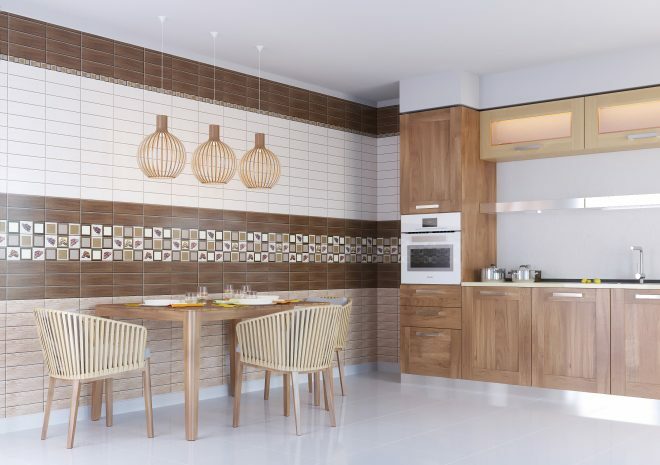
Advantages and disadvantages of PVC panels
Products made of polyvinyl chloride are notable for their low cost, due to low production costs and low cost of raw materials. Other advantages of plastic are:
Attention! Earned on our website kitchen designer. You can familiarize yourself with it and design your dream kitchen for free! May also come in handy wardrobes designer.
- A small mass of parts, which simplifies the renovation of the kitchen with PVC panels.
- The material resists moisture well. The plastic surface can be washed and the stains can be wiped off with a sponge. Moisture trapped on the plane will not be absorbed into its structure, it will soon evaporate.
- Long period of material exploitation. Such products can last up to 10 years while maintaining their basic qualities.
- Mold and rot do not appear on the surface of the products under consideration, the material does not conduct current.
- Plastic panels for the kitchen are easy to install. These elements can be installed with your own hands with minimal investment of time and physical effort.
- The products have an attractive appearance, which allows the user to choose the option that suits them.
- Plastic is resistant to sudden changes in temperature.
There are really many advantages to PVC panels, but this material has several significant disadvantages. It is flammable, products ignite on contact with open fire. In addition, the material in question is not strong enough with respect to mechanical stress.
Varieties of panels
Decorating a kitchen with panels begins with choosing the appropriate product option. The material can be designed in different ways, but it must fit into the existing design of the room.
Lining
The material in question resembles a lining made of wood. It is used not only for wall decoration. In addition, the product is used for the device of the apron. Let's get acquainted with the features of the lining:
- The width of the products is 10-12 centimeters, the length of individual elements reaches 6 meters.
- The surface of the lining for the kitchen often imitates wood, but there are models with a monochrome color.
- The material is strong enough.
Plastic kitchen panels are often installed vertically, which will visually increase the height of the room. To expand the room, the lining is laid horizontally; there is also a combined installation option.
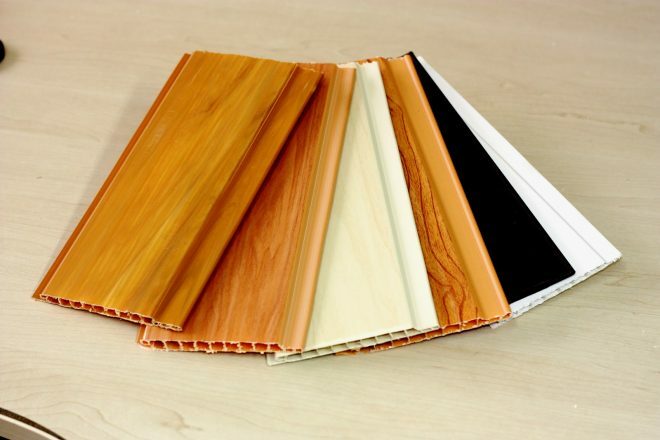
Set panels, slats
One of the options for wall decoration is plastic panels for the kitchen. The photo shows how beautiful and harmonious they can look indoors.
The main features of the products:
- The width is within 25-50 centimeters, the length of the material is 2.6-3 meters.
- By the method of fastening and appearance, the slats resemble lining.
- The material in question is fixed on a pre-installed crate, and the joints are covered with moldings.
Rack type-setting elements are used for finishing all surfaces in the kitchen.
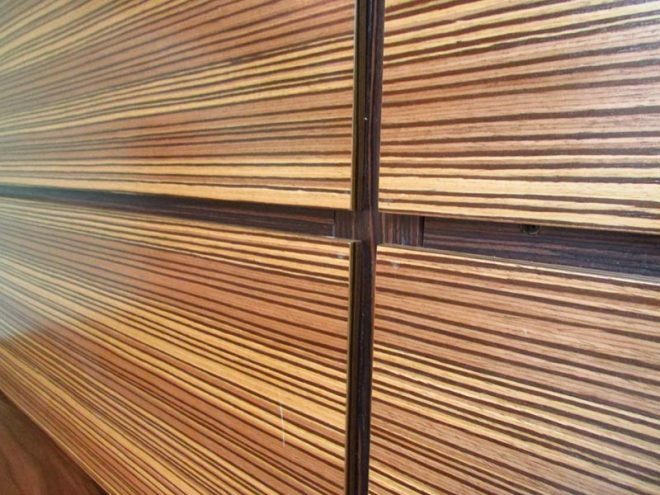
Tile
PVC tiles are somewhat similar to ceramics. These products can have different sizes and surface colors.
Tile characteristics:
- The most popular product sizes are considered to be 30 * 30 centimeters.
- The thickness of the tiles is 8-25 centimeters.
- The material is mainly used for apron mounting.
- The design of the tiles can be very diverse, its surface imitates wood, natural stone, etc.
For the installation of plastic products, a crate is used. The tiles are connected into a single structure thanks to the use of locks that work according to the groove-comb principle.
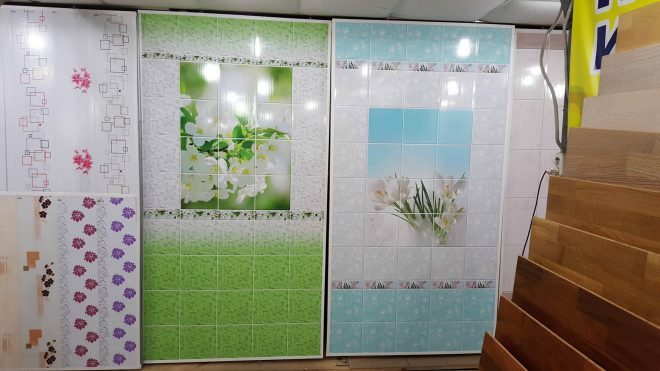
Sheet plastic
This material looks like a tile in appearance, but it is much longer and wider than its counterpart. The thickness of the plastic sheet is in the range of 3-6 millimeters. After installing such parts, all joints are filled with sealant.

Selection recommendations
When buying plastic panels, you must follow these recommendations:
- The overall dimensions of the products should slightly overlap the apron area in order to hide the unfinished walls behind the stove, cabinet or table.
- When installing decorative elements near the hob, buy products that are resistant to high temperatures.
- The design of the products, as well as their color scheme, is selected in accordance with the dimensions and interior of the room. So dark tones are better suited for spacious rooms, at the same time, light shades can visually expand the space of a small kitchen.
To diversify the design of the room, purchase various metal inserts or products that imitate the surface of a tree.
Color and pattern
Decorating the kitchen with wall panels looks very original and unusual. To decorate wall surfaces, various types of products are used in different colors. Let's consider the most popular options:
- One-color products with red, white, orange, white, blue, blue, green or brown surfaces.
- Materials that imitate wood texture, natural stone or water surface.
In addition to these types, there are models of wall panels on which images of various vegetables, plants and other patterns are applied.
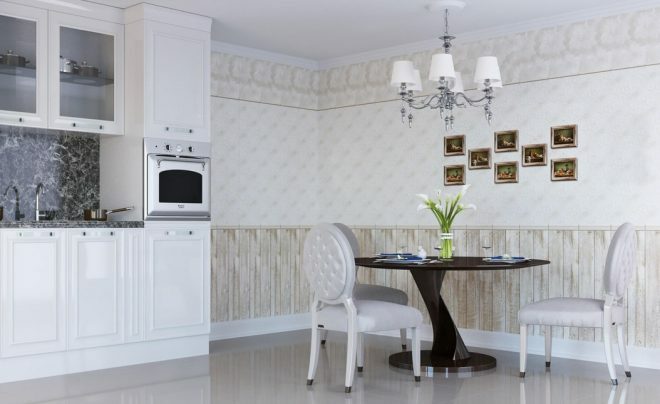
Kitchen apron decoration
The kitchen apron is in the work area, but it adds a special style to the whole room. This element must fit into the existing interior and perfectly match all furniture elements.
When using PVC panels for the installation of an apron in the kitchen instead of tiles, the following must be taken into account:
- The material must protect the wall from water, oil or grease splashes, dust and dirt accumulation.
- Housewives prepare food in the work area, so it is necessary to choose plastic products with high strength values.
A unique apron with images of vegetables and fruits will allow you to decorate the kitchen. When choosing this option, make sure that the appearance of the work area fits into the design of the room.
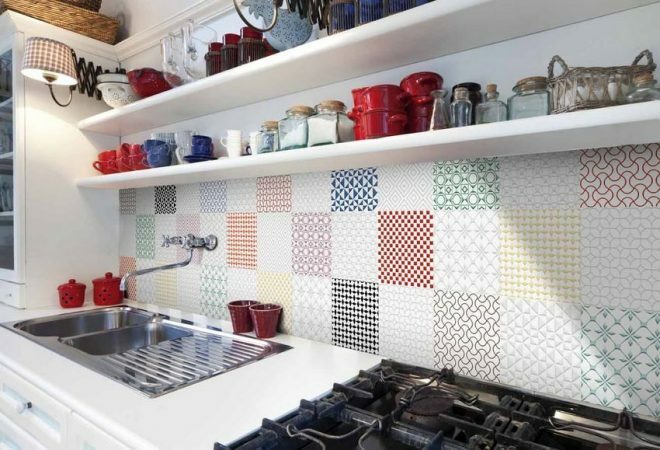
Kitchen surface finishing with plastic panels
Before laying plastic panels in the kitchen instead of tiles, it is necessary to consider all the stages of work.
Required tools
First, you need to measure the room and buy the required amount of material. An additional 5% is added to the calculated value for a possible trimming. After that, we prepare a working tool:
- electric drill and set of drills;
- puncher;
- construction tape for measurements;
- pencil;
- building level;
- stationery knife.
When all the inventory is ready, you can start the main process.
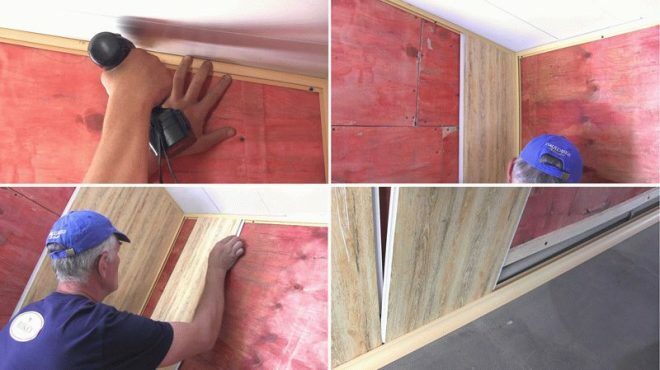
Preparatory work
Wall preparation consists of removing the old covering. If old wallpaper remains on the base, they are soaked in water, and then cleaned off with a metal spatula. Previously painted walls are cleaned using an electric drill with a nozzle. In addition, the paint can be removed with a construction hairdryer, when the coating is blown, it is carefully removed with a spatula. All irregularities and cracks on the base are putty. After the surface is dry, it must be sanded.
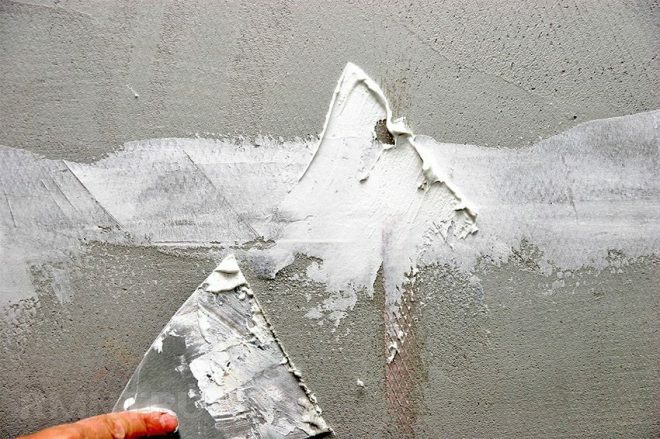
Wireframe method
To install panels using this method, it is necessary to prepare smooth wooden slats or a special metal profile for the frame. Wood products are impregnated with antiseptics and fire retardants. Such solutions will protect the material from overheating, prevent mold and rot.
Installation of panels is carried out in the following order:
- The guides are attached to the base with dowels. Self-tapping screws can be used for the same purpose. The planks are oriented at an angle of 90 degrees in relation to the decorative elements.
- The frame elements must bypass all engineering communications.
- During the installation of the guides, they use the building level, all the slats must be strictly vertical and form one plane.
- The distance between the guides is within 40 centimeters.
After the installation of the frame, the installation of fittings, external and internal corners, as well as final components is carried out. In the case of installing panels on the entire wall surface, a ceiling plinth is fixed in the upper part of the room. Installation of panels begins from the corner, while a groove is cut off at the side element, which will create a high-quality joining. The position of the decorative elements is checked using a level; they are fixed to the frame with staples or self-tapping screws.
Frameless method
In this case, the installation of PVC products is similar to the installation of tiles. First you need to level and prime the base surface. When the solution is dry, the master mixes the glue according to the instructions on the package.
The mortar is applied to the wall with a notched trowel, then the panel is laid on the mixture. The rest of the products are pressed against the wall, and then joined on the locks. The outer panels are fixed to the surface with brackets. Self-tapping screws can be used for the same purpose. During the work, the position of the panels is checked by the building level.

Conclusion
Decorating a kitchen with plastic products is considered one of the most practical finishing options. For this work, it is necessary to choose durable, wear-resistant and fire-resistant materials. The created surface must be in harmony with all elements of the furniture, therefore, before carrying out work, you must view a photo with various decoration options for the existing interior.
average rating 0 / 5. Number of ratings: 0
No ratings yet. Be the first to rate.


